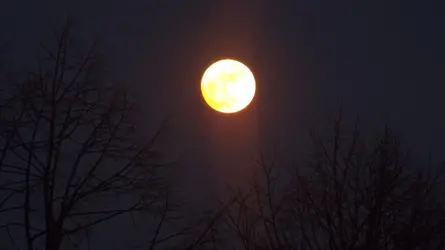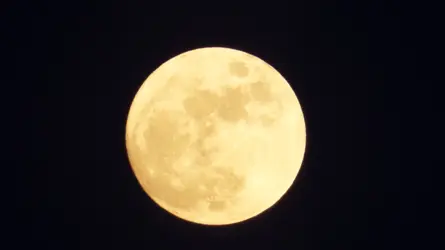You are using an out of date browser. It may not display this or other websites correctly.
You should upgrade or use an alternative browser.
You should upgrade or use an alternative browser.
Another shots of the moon.
- Thread Starter xDarek
- Start date
TCampbell
Been spending a lot of time on here!
- Joined
- Mar 31, 2012
- Messages
- 3,614
- Reaction score
- 1,558
- Location
- Dearborn, MI
- Can others edit my Photos
- Photos OK to edit
While the yellow/gold color looks great, these are both a bit over-exposed. The first image shows clipping in the histogram. The second image doesn't show clipping, but lacks the contrast that you'd expect when looking at the moon.
Your second image was shot at: ISO 100, f/5.6, 1/13th sec.
You'd get more contrasty detail on the moon at a higher shutter speed. Normally I'd go 1/320th sec for this. But since the moon is low, the atmosphere (which is why it appears yellow) is cutting some light, so it might get backed down to compensate. I might guess at perhaps 1/250th or possibly even 1/200th and then vary the exposure based on how that works out.
Here's a sample shot of the Moon using the rule I mentioned earlier... this is the "Loony 11" rule which says that if you set the aperture to f/11 then the shutter speed is always the inverse of the ISO setting. So at ISO 100, use 1/100th sec. At ISO 200, use 1/200th sec. At ISO 400, use 1/400th sec. etc. You can use other aperture and trade stops of aperture for shutter speed.
Anyway, the story behind this shot is that I was at one of my astronomy club's "Beginner's Nights" when we invite the public or anyone who just needs some beginning astronomy help. One person asked me how to take an image of the moon through a telescope and I explained the rule. But I happened to have my camera with me (normally I wouldn't have it on such a night) so I attached the camera to the telescope, set the exposure based on the rule, focused, and took only ONE shot. This is that shot. The point is... once you know the rule there is no need to guess. You'll nail the exposure every time.

BTW, this is shot using a telescope, not a camera lens, so this the focal length here is close to 1000mm.
Also note that the surface detail shows up nicely (the moon has lots of texture) because the Sun is lighting it from the side.
Your second image was shot at: ISO 100, f/5.6, 1/13th sec.
You'd get more contrasty detail on the moon at a higher shutter speed. Normally I'd go 1/320th sec for this. But since the moon is low, the atmosphere (which is why it appears yellow) is cutting some light, so it might get backed down to compensate. I might guess at perhaps 1/250th or possibly even 1/200th and then vary the exposure based on how that works out.
Here's a sample shot of the Moon using the rule I mentioned earlier... this is the "Loony 11" rule which says that if you set the aperture to f/11 then the shutter speed is always the inverse of the ISO setting. So at ISO 100, use 1/100th sec. At ISO 200, use 1/200th sec. At ISO 400, use 1/400th sec. etc. You can use other aperture and trade stops of aperture for shutter speed.
Anyway, the story behind this shot is that I was at one of my astronomy club's "Beginner's Nights" when we invite the public or anyone who just needs some beginning astronomy help. One person asked me how to take an image of the moon through a telescope and I explained the rule. But I happened to have my camera with me (normally I wouldn't have it on such a night) so I attached the camera to the telescope, set the exposure based on the rule, focused, and took only ONE shot. This is that shot. The point is... once you know the rule there is no need to guess. You'll nail the exposure every time.
BTW, this is shot using a telescope, not a camera lens, so this the focal length here is close to 1000mm.
Also note that the surface detail shows up nicely (the moon has lots of texture) because the Sun is lighting it from the side.
Last edited:
xDarek
No longer a newbie, moving up!
- Joined
- Dec 29, 2015
- Messages
- 518
- Reaction score
- 169
- Location
- Romania
- Can others edit my Photos
- Photos NOT OK to edit
- Thread Starter 🔹
- #3
Wow, that's amazing, thank you again for the tips, you are a great man!!! Thank you again!While the yellow/gold color looks great, these are both a bit over-exposed. The first image shows clipping in the histogram. The second image doesn't show clipping, but lacks the contrast that you'd expect when looking at the moon.
Your second image was shot at: ISO 100, f/5.6, 1/13th sec.
You'd get more contrasty detail on the moon at a higher shutter speed. Normally I'd go 1/320th sec for this. But since the moon is low, the atmosphere (which is why it appears yellow) is cutting some light, so it might get backed down to compensate. I might guess at perhaps 1/250th or possibly even 1/200th and then vary the exposure based on how that works out.
Here's a sample shot of the Moon using the rule I mentioned earlier... this is the "Loony 11" rule which says that if you set the aperture to f/11 then the shutter speed is always the inverse of the ISO setting. So at ISO 100, use 1/100th sec. At ISO 200, use 1/200th sec. At ISO 400, use 1/400th sec. etc. You can use other aperture and trade stops of aperture for shutter speed.
Anyway, the story behind this shot is that I was at one of my astronomy club's "Beginner's Nights" when we invite the public or anyone who just needs some beginning astronomy help. One person asked me how to take an image of the moon through a telescope and I explained the rule. But I happened to have my camera with me (normally I wouldn't have it on such a night) so I attached the camera to the telescope, set the exposure based on the rule, focused, and took only ONE shot. This is that shot. The point is... once you know the rule there is no need to guess. You'll nail the exposure every time.
View attachment 114795
BTW, this is shot using a telescope, not a camera lens, so this the focal length here is close to 1000mm.
Also note that the surface detail shows up nicely (the moon has lots of texture) because the Sun is lighting it from the side.
Most reactions
-
 236
236 -
 118
118 -
 86
86 -
 84
84 -
 82
82 -
 82
82 -
 82
82 -
 79
79 -
M
65
-
 62
62 -
 62
62 -
 53
53 -
 52
52 -
 48
48 -
 45
45
Similar threads
- Replies
- 14
- Views
- 390
- Replies
- 16
- Views
- 812





![[No title]](/data/xfmg/thumbnail/37/37604-7ad625e983f92f880eb65a264eeef5e4.jpg?1734170732)









